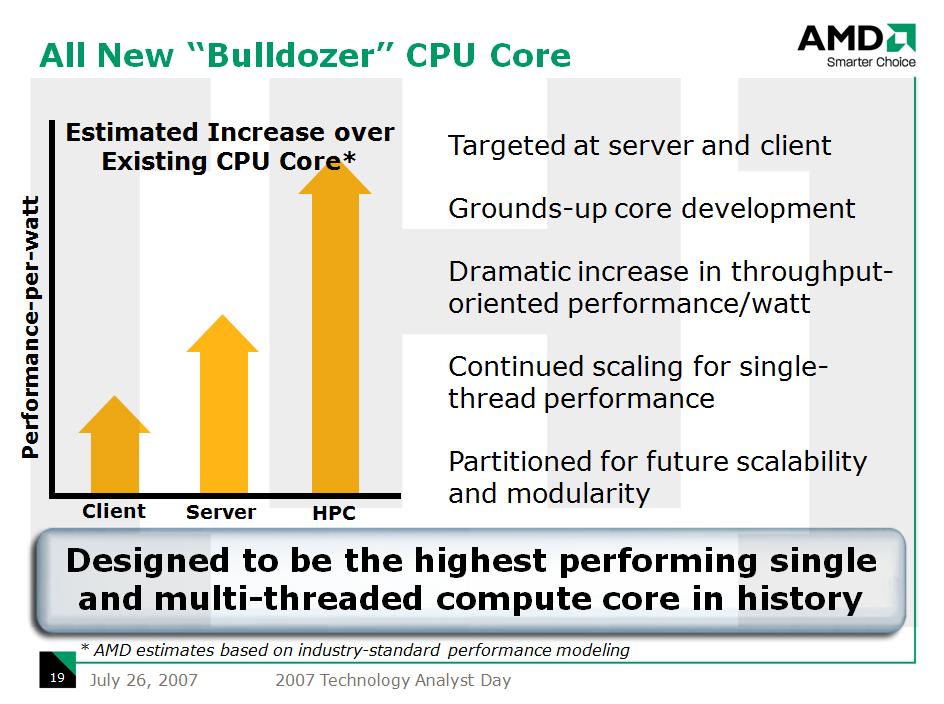AMD plots 16-core super-CPU for 2009

AMD is preparing an all-new PC processor with up to 16 execution cores. Due out in the first half of 2009, the new architecture is codenamed Bulldozer. In an official announcement, AMD said Bulldozer will be its first substantially new CPU core since the original Athlon 64 processor of 2003. And it'll be the first ground up architectural redesign since the K7 Athlon of 1999.
In that context, it's likely the Bulldozer architecture will provide the foundations of AMD CPUs for many years to come. In other words, the architecture is rather important. The news is the latest in a flurry of announcements from AMD's PR machine in the past week. AMD has already revealed plans for a second-gen quad-core processor known as Shanghai and demoed its upcoming Phenom quad-core desktop chip running at 3GHz.
Meanwhile, the world is still waiting for Barcelona, AMD's first generation quad-core CPU , to appear. AMD has promised that Barcelona will launch later this August.
Bulldozer is the name, crushing Intel is the game
But what about Bulldozer? The big news is that it will form the basis of AMD's first massively multi-core PC processor with up to 16 execution cores. Bulldozer will also be fully compatible with AMD's so-called M-SPACE modular CPU design.
Along with traditional PC processors, therefore, expect to see AMD Fusion CPUs powered by Bulldozer cores but also offering a range of specialised processing units. Think graphics processing cores and high-definition video decoding engines and you'll get an idea of the sort of additional functionality Bulldozer-based Fusion processors will deliver.
As for the main execution cores themselves, they retain the same basic out-of-order superscalar design as AMD's existing PC processors. However, Bulldozer will utilise a deeper instruction pipeline. That's a measure traditionally introduced to allow higher clockspeeds. However, deeper pipelines typically also reduce clock-for-clock performance.
Bulldozer also receives a range of new instructions designed to accelerate media processing and performance in high performance computer clusters. With as many as 16 cores humming away, keeping Barcelona fed with data will obviously be a tough task. In response, AMD says the chip will benefit from "highly scalable memory and I/O performance".
Sign up for breaking news, reviews, opinion, top tech deals, and more.
Specifically, that means a new version of AMD's Direct Connect technology along with four HyperTransport 3.0 links per processor. Support for ultra fast DDR3 memory as well as AMD's G3MX memory extender technology will further boost the data and bandwidth available to Bulldozer. AMD's G3MX technology is designed to allow increased system memory without resorting to Intel 's power-hungry FBDIMM approach.
How fast is she, mister?
It all sounds pretty impressive on paper. But how fast will this 16-core chip be in practice? Well, according to AMD, Bulldozer is designed to be nothing less than "the highest performing single and multi-threaded compute core in history".
If AMD is to be believed, Bulldozer will improve upon every metric of CPU performance. From performance per watt to outright multi-threaded performance and old school single-threaded oomph, it's promised Bulldozer will be the new king.
Of course, by 2009 Intel will be shipping some fairly exotic kit of its own. A major revision of Intel's Core architecture, complete with an integrated memory controller and HyperTransport-bashing Common Serial Interface, is pencilled in for 2008 with a further revised variant in 2009.
What's more, with that longer instruction pipeline in mind, it will be interesting to see how Bulldozer pulls off improved single-threaded performance. Rumours are currently circulating that Bulldozer may be capable of thread-fusing or using multiple cores to compute a single thread. Thread fusing is one of the holy grails of PC processing. If Bulldozer is indeed capable of such a feat, the future could be very bright indeed for AMD.
Tech.co.uk was the former name of TechRadar.com. Its staff were at the forefront of the digital publishing revolution, and spearheaded the move to bring consumer technology journalism to its natural home – online. Many of the current TechRadar staff started life a Tech.co.uk staff writer, covering everything from the emerging smartphone market to the evolving market of personal computers. Think of it as the building blocks of the TechRadar you love today.